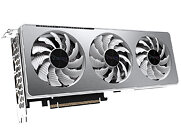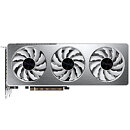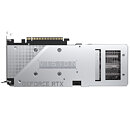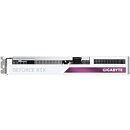- Joined
- Oct 9, 2007
- Messages
- 47,648 (7.44/day)
- Location
- Dublin, Ireland
| System Name | RBMK-1000 |
|---|---|
| Processor | AMD Ryzen 7 5700G |
| Motherboard | Gigabyte B550 AORUS Elite V2 |
| Cooling | DeepCool Gammax L240 V2 |
| Memory | 2x 16GB DDR4-3200 |
| Video Card(s) | Galax RTX 4070 Ti EX |
| Storage | Samsung 990 1TB |
| Display(s) | BenQ 1440p 60 Hz 27-inch |
| Case | Corsair Carbide 100R |
| Audio Device(s) | ASUS SupremeFX S1220A |
| Power Supply | Cooler Master MWE Gold 650W |
| Mouse | ASUS ROG Strix Impact |
| Keyboard | Gamdias Hermes E2 |
| Software | Windows 11 Pro |
GIGABYTE today introduced the GeForce RTX 3060 VISION graphics card targeted at creators. This is the company's fourth such card based on an "Ampere" series GPU. When paired with NVIDIA's GeForce Studio drivers, the card provides a formidable feature-set and optimization for content creation suites, making this a quasi-ProVis graphics card.
The design of the card is similar to most other RTX 30-series VISION cards—a large white cooler shroud hides an aluminium fin-stack heatsink. This shroud is topped off with a brushed aluminium plate. The cooler is optimized for low-noise, and idle fan-stop, and features fans with graphene-lubricated double ball-bearing fans. Airflow from the third fan flows through the card, and out from a cutout on the back-plate. The card pulls power from a single 8-pin PCIe power connector. You also get a handy factory-overclock of 1837 MHz boost (vs. 1777 MHz reference). Display outputs include two each of HDMI 2.1 and DisplayPort 1.4a connectors. The card is expected to be priced around $400.





View at TechPowerUp Main Site
The design of the card is similar to most other RTX 30-series VISION cards—a large white cooler shroud hides an aluminium fin-stack heatsink. This shroud is topped off with a brushed aluminium plate. The cooler is optimized for low-noise, and idle fan-stop, and features fans with graphene-lubricated double ball-bearing fans. Airflow from the third fan flows through the card, and out from a cutout on the back-plate. The card pulls power from a single 8-pin PCIe power connector. You also get a handy factory-overclock of 1837 MHz boost (vs. 1777 MHz reference). Display outputs include two each of HDMI 2.1 and DisplayPort 1.4a connectors. The card is expected to be priced around $400.





View at TechPowerUp Main Site



